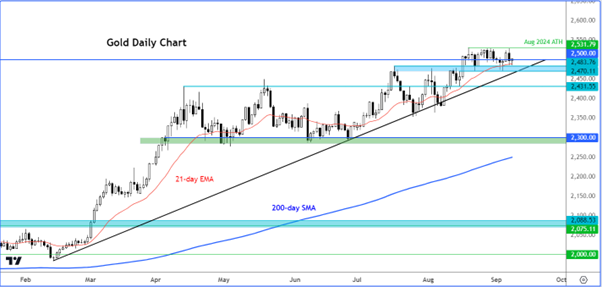The US dollar, and consequently gold, experienced quite a bit of intra-day volatility on Friday due to weaker-than-expected US jobs data and a couple of Federal Reserve speeches, leaving uncertainty about whether the Fed will cut interest rates by 25 or 50 basis points on September 18, notes Fawad Razaqzada, technical analyst at Trading Candles.
This week's US inflation data might provide more clarity. Despite any short-term fluctuations, gold is likely to remain supported on the dips, having outperformed other risk assets this year. The yellow metal is benefiting from several factors: expectations of rate cuts from the Fed and other central banks, safe-haven demand driven by geopolitical risks, and increased physical purchases by central banks.
Before discussing macro influences on the dollar and gold further, let’s first have a quick look at the gold price chart.
Gold Maintains Strong Trend
While there’s a chance of a short-term pullback due to the recent loss of bullish momentum, the fact that the gold price has held steady around the $2500 mark suggests the path of least resistance remains upward.

Gold has been trading within a tight range, hovering near its all-time high from August. The shallow nature of recent dips doesn’t indicate an imminent drop. Of course, this could change in the coming weeks, but based on current market conditions, it's hard to be overly bearish on gold just yet.
Key short-term support lies between $2470 and $2485. This zone aligns with previous support and resistance levels, intersects with the bullish trendline established since February, and coincides with the 21-day exponential moving average.
For the bulls, the first upside target is the liquidity above the August all-time high at $2531, with the next major goal at the $2600 level.
US Dollar Outlook Remains Bearish
Following a weaker US jobs report, we saw the dollar drop across the board, before returning to pre-NFP levels and then turning positive on Friday, against all major currencies except the yen. The dollar’s stronger reaction to the NFP data and its moderate further strength observed so far in the first half of Monday’s session is likely driven by short-side profit-taking. Investors were also probably left wondering how much of the weakness was already priced in given the fact we had already seen several other labor market data come in weaker, ahead of the NFP report. Enthusiasm for a 50 basis point cut faded after Fed’s Williams played it safe during his speech, even if Waller was more dovish. With investors now completely unsure whether the Fed will opt for a 25 or 50 basis points rate cut, this week’s CPI data – the last major release before the FOMC’s meeting on September 18 – may well be the deciding factor. With the Fed pivoting, the US dollar will likely fall over time, which should keep gold supported on the dips.
Fed Cannot Wait Any Longer to Cut Rates After Disappointing Jobs Data
Despite the uptick in wages, Friday’s release of the August jobs report was rather weak. Not only did the headline data show only a modest +142K rise in nonfarm jobs in August (vs. +165K expected), but revisions also reduced reported employment for June and July sharply - by a good 86K. This was the weakest jobs report since the days of the pandemic in December 2020. What’s more, private-sector hiring is now averaging just +96,000 over the last three months, falling from a three-month average of 146,000 in July. This is almost alarming.
With the jobs market cooling more than expected, the Fed cannot and should not wait any longer to cut rates. Not that was ever in any doubt after the Fed Chair Jerome Powell had made it clear at the Jackson Hole conference that the Federal Reserve would cut interest rates on 18 September, stating that "the time has come for policy to adjust. The direction of travel is clear."
The market is 50-50 in terms of the scale of the rate cut. The Fed will want to avoid causing a major dollar move when it meets next week, and they will hope that this week’s US inflation data, the main data on the economic calendar, will help make their rates decision a more expected outcome.
US CPI is Expected to Cool to 2.6%
With US CPI on course to drop towards the Fed’s target, Powell has already given the green light for cutting interest rates at the September 18 FOMC meeting. Wednesday’s CPI report will be the last major data release before that meeting to help rate-setters whether to go for 50 or opt for the standard 25 basis point cut. It will thus garner a lot of attention – especially if we see a sharp deviation from the expected figure. Inflation slowed for a fourth month to 2.9% y/y in July, falling to the lowest since March 2021. In August, it is expected to drop even further to 2.6%. Core CPI is expected to remain unchanged at 3.2% y/y.






















